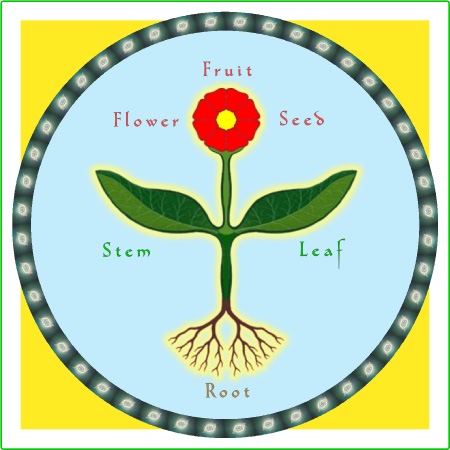THREE BASIC GROUPS
All foods that come from the plants – with the few exceptions explained in
the texts referred below – can be divided into three basic groups presented with
the following symbols:
 |
 |
 |
| Lower part |
Middle parts |
Upper parts |
Roots
Beetroot
Carrot
Celeriac
Turnip
etc. |
Stems [1]
Celery
Fennel
etc.
Leaves
Lettuce
Kale
Cabbage, etc.
|
Flowers
Elderflower, etc.
Fruits
Cherries
Sweet Red Pepper
Squash, etc.
Seeds
Beans
Nuts, etc.
|
♣ For an enlarged list of the vegetables divided
into these groups see THREE GROUPS OF VEGETABLES
The specific quality of cultivated plants is in their one-sidedness:
carrot is one-sided root, lettuce is one-sided leaf; rhubarb is one-sided
stem; pumpkin is one-sided fruit part of the plant; apple is one-sided fruit
and so on. There are a few exceptions, like celery where we use its root,
its stem and leaves and even its seeds. [2] But even in this case we usually
do not use them in the same dish or meal, but we use either roots or stems
or seeds for seasoning. Thus we can see that most of the cultivated fruit
and vegetables are one-sided foods. For that very reason we try to balance
them when we design a meal. The only exception is the grains which are not
taken into account when we combine plant ingredients according to this
principle.
♣ For an explanation
why grains are an exception see ARCHETYPE OF A GRAIN
Although there is a difference between the fruit parts of vegetable
plants (courgette, tomato, pumpkin, etc.) and proper
fruits (apple, peach,
cherry, etc.), they both develop from the flower part of a plant. There is
also a nutritional difference between pulses
(beans, lentils, etc) which contain more proteins and seeds (sunflower seeds, sesame seeds, etc) and
nuts (almonds,
hazelnuts, etc) which contain more fats. In spite of this we count all of them in
the Flower–Fruit–Seed group when we compose a meal according to the
principle of the threefold plant. Of course, we can try if possible to use
fruit and vegetables from all these groups in a single meal. It is an option
but not a necessity!
THE MAIN PRINCIPLE OF BALANCING
The basis of this principle is the archetype of the
plant developed by Goethe. The aim of this principle is to create from the
various parts of the different plants a whole new plant. As the proper
plants are consisting of Root,
Stem or Leaf, and
Flower or Fruit or
Seed, so it is needed also for our creations. [3] For example, using carrots,
spinach, and pumpkin in a one-pot dish (or in the various dishes of the same
meal) we have created a new ‘plant’ with:
- Carrot as its Root
- Cabbage as its Leaves
- Pumpkin as its Fruit
We see that this principle is applicable in the case when we cook with fresh
vegetables and fruit. Of course, this doesn't exclude the use of processed
vegetables and fruit, such as tomato puree, or apricot jam, when we have product
made from a single main ingredient. The products which contain all three groups
might be more convenient, but their use doesn't stimulate our creativity!
Another way of creating a threefold plant is with the use of oils (made from the
seeds or
fruit) and dried herbs and spices (counted as
the Root part because they have, in the process of
growing or drying, 'hardened' into fibrous substance full of minerals). Salt is also counted as
Root part, because it belongs to the mineral
kingdom in which the roots of plants grow. What is common to salts, dried
herbs, spices, and roots is that they are all rich sources of minerals.
For example, we can create a simple balanced dish with:
- Natural salt as its Root
[4]
- Spinach as its Leaves
- Sunflower oil as its
Fruit
CREATING A WHOLE MEAL WITH THIS APPROACH
When you cook a meal with more than one dish you strive to
have all main parts of the plant in the whole meal. For example, beside the
grain dish we can prepare:
- Soup with parsnip - Root
- Salad with lettuce -
Leaves
- Lentils as side dish -
Seeds
In this way we create a threefold 'plant' inside the whole meal.
♣ For preliminary help in
composing whole meals see EXAMPLES OF BALANCED MEALS
When you have mastered the use of this principle presented here so that
it became part of your cooking 'habit' then you can – if you wish – go to
the next, more advanced level of the use of the principle of the threefold
plant.





